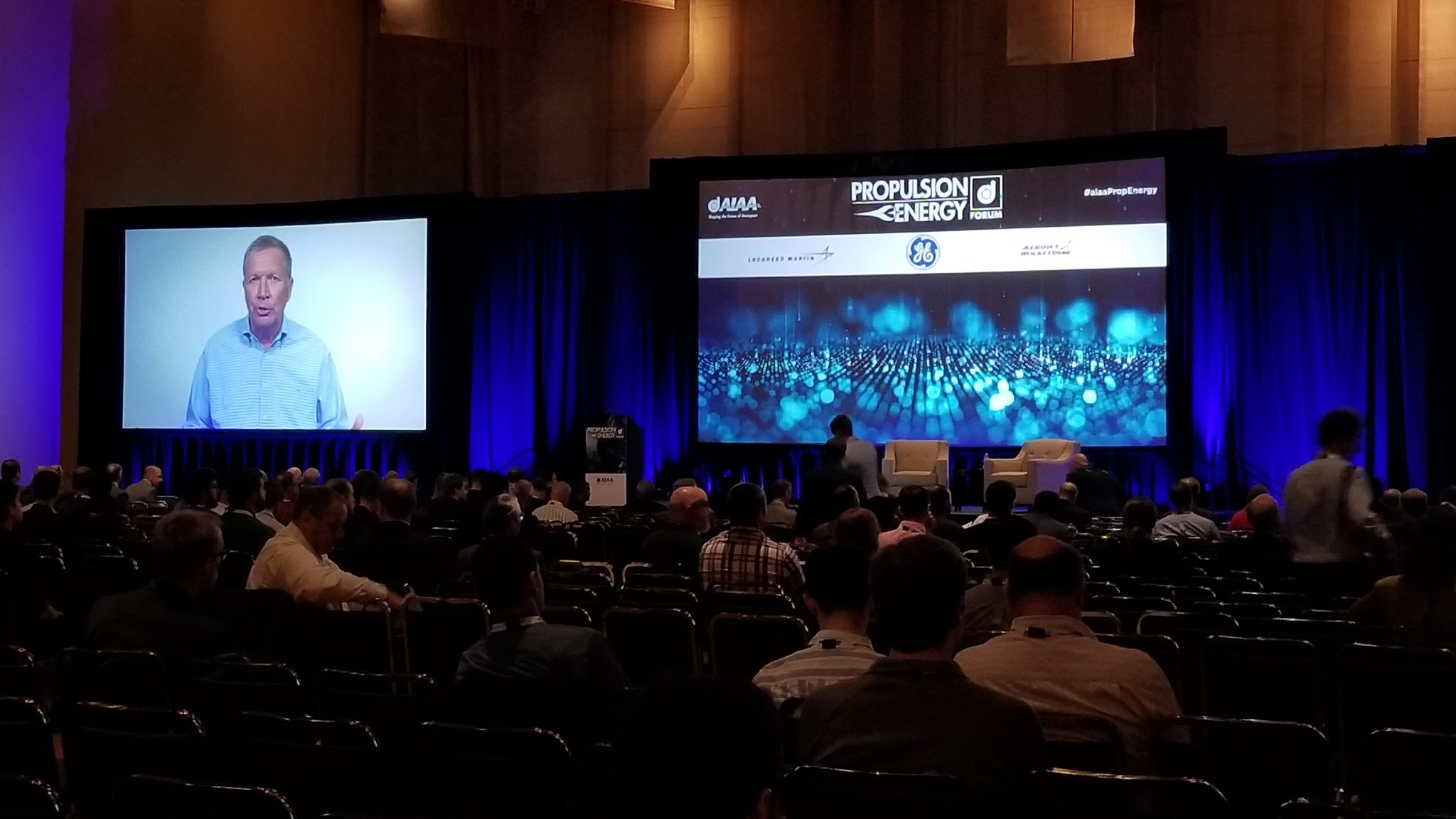I’ve traveled more
by air the last 3 weeks than I have ever before, going first to New Mexico for
the Spaceport America Cup, Florida for the CRS-15 launch, and now most
recently, Ohio for the AIAA Propulsion and Energy Forum in Cincinnati.
This trip was with
the other twelve interns of the Propulsion Academy to experience two of the
three primary days of this conference. We left Sunday morning and got situated
at the Westin in downtown Cincinnati.
 |
| Photo Courtesy of AIAA |
First thing Monday
morning was a talk by keynote speaker, Janet Kavandi, a former astronaut of
three Shuttle missions. She spoke about SLS and NASA’s future. It ended with
some Q&A, and the host asked her what students could be doing if they have
interests in joining NASA. She went on to say that they’ve never had a shortage
of interested young engineers, so I heard that as we students are expendable. I
didn’t exactly appreciate that.
The rest of the
morning included presentations by many industry representatives, professors,
and students from every aspect of propulsion including airbreathing, small
unmanned systems, launch vehicle propulsion, solid rocket motors, hybrid
rockets, liquid engine components, monopropellants, in-space propulsion, and
future propulsion systems. It was pretty great. Two I found of particular
interest were a study of the RS-25 given by a grad student at UAH (I introduced
myself afterwards to learn about his graduate work and internship experiences
at Blue Origin) and an academic project done by several students from South
African who designed a SmallSat launcher for the nation of South Africa given
conservative performance and design parameters. This was a student project that
covered purely on-paper design, yet there were still those “experts” in the
audience who asked if they’d hot-fired their engine or built a test bed yet. I
feel that the Q&A following a presentation is usually just a pissing
contest for people to “preface” their question by talking for 30 seconds about
their credentials, or how much they know. I’m hereby vowing to never do that
myself.
That afternoon was
the highlight of the entire conference for me. I attended a panel discussion by
members of the small launch vehicle industry. It featured Ron Litchford of NASA,
John Fuller of Virgin Orbit, Tim Ellis of Relativity Space, and Will Coogan of
Firefly Aerospace. Peter Beck, Rocket Lab’s CEO, was also scheduled to speak but
was unable to make it. They each gave presentations about their respective
companies and then answered questions from the audience. These were three of
the most engaging hours I can remember, and I wrote some 3 pages of notes about
their presentations and their answers to questions about additive
manufacturing, working with the government, and how small companies are targeting
success in an industry largely populated by enormous companies that are older
than NASA. It was fascinating both in their engineering and manufacturing processes
to how they secure funding and investing. Tim Ellis was particularly engaging
and offered a unique perspective since the others were in engineering. He spoke
a bit more about his vision and direction for the company as they attempt to 3D
print entire rockets autonomously.
Following the
Q&A, I spoke with Will Coogan personally and learned about their operations
outside of Austin, TX while most rocket companies are in LA. I also spoke
one-on-one with Tim Ellis and asked him about his role as CEO having had an
extensive engineering background early in his career. We both watch Silicon
Valley, and he said these startup space companies really do have a similar feel
to Richard Hendrix and Pied Piper from the show. I told him briefly about the
rocketry team, and how I really hope to be in the small launcher business. It
was such a solid afternoon, and I felt positively exhausted from the excitement
and mental stimulation from the day.
That evening I
emailed both Will and Tim thanking them for their time in speaking with us. Tim
even wrote me back within about ten minutes and wished me good luck with the
rocketry team. I was elated.
Tuesday wasn’t of
the same caliber, but that was fine because Monday was so exceptional. I
attended Dr. Rouser’s presentation on turboelectric for small UAS. It was very
well received with a large audience, and he was engaged in conversation for a
while afterwards. We were the only ones from Oklahoma universities that we were
aware of, and he did a great job of discussing OSU’s advanced capabilities in
aerospace and propulsion. Following the morning’s presentations, I felt a bit
burned out, so I took some introvert time alone throughout the afternoon and
evening by watching Iron Man and playing Kerbal Space Program.
We left early
Wednesday morning to return to Huntsville. I was grateful for the opportunity
to attend this conference, and it reaffirmed that I studied the right thing in
school and am pursuing careers in the right field. I’m looking forward to how
the involvement and presentations by small launchers will grow and evolve at such
conferences in the future. I hope to be participating.
Comments
Post a Comment